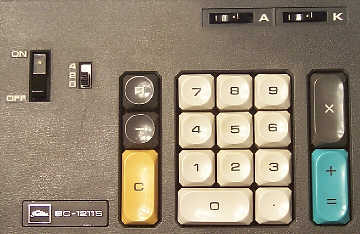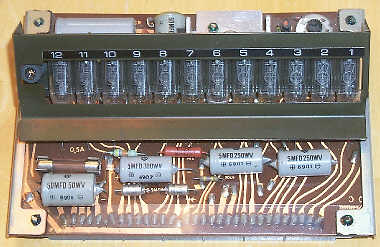| +Home | Museum | Wanted | Specs | Previous | Next |
Toshiba BC-1211S Electronic Calculator
Updated 5/14/2023
The BC-1211S is a rather interesting machine -- one of a few machines made by various manufacturers in the late 1960's and early 1970's designed to reduce the cost of an electronic calculator for business applications by simply eliminating the division function. Look closely at the photo, and you'll note that there's no [÷] key to be found on the keyboard.
Toshiba created and marketed a number of machines in the BC-121x series, including the
four function "big brother" machine called the BC-1212 which adds division,
and the BC-1213 which adds an exchange registers key to the BC-1212.
These machines all share identical cabinetry, display subsystem, power supply,
switchgear, and two of three circuit boards. The BC-1212 and BC-1213
use more complicated circuitry than the BC-1211S, indicating that the 1211S
is a unique design, purposefully made without the logic to perform division.
Another example of a calculator without the division function is the
Denon DEC-311.
Detailed view of Toshiba BC-1211S keyboard. No divide key!
Division is the most complex of the basic four math functions to implement with
electronics. Most electronic implementations of division rely on counting
repeated subtractions of the dividend from the divisor until an overdraft
occurs, then restoring the result from the last subtraction (generally by
adding the dividend back in) performing a shift operation, and continuing
repeated subtractions until all of the digits of the quotient have been
calculated. Because of the complexity of the sequencing circuitry
required to perform these operations, and given that division is the
least-frequently used calculation in basic business accounting, a number of
calculator manufacturers came to the conclusion that making a calculator
that did not provide the division function, at a slightly lower cost, would
entice business people to get rid of their mechanical calculators and
replace them with new electronic technology. In some cases, the
calculators were actually designed with division circuitry omitted,
and in other cases, the divide key was simply not included on the keyboard.
In either case, it was a psychological ploy by the manufacturers to get
conservative business types to make the jump to electronic calculating
machines. This market strategy was short-lived, as ever-increasing levels
of sophistication in integrated circuit technology made it such that was
actually more expensive to make a special design that didn't perform
division than it was to make a general-purpose four function calculator.
Toshiba BC-1211S without upper cabinet
The Toshiba BC-1211S offers twelve digits of capacity, fixed decimal
point locations at 0, 2, and 4 digits behind the decimal, constant mode
for multiplication, and a sum-of-products accumulation mode. Addition,
subtraction, and multiplication operate as usual for calculators of the day.
Decimal point is floating on input, meaning that the decimal point can be
located anywhere in the number that is input, but as soon as an operation
is performed on the number, it is truncated to the number of digits behind
the decimal selected on the decimal position switch. The machine allows a
two-key squaring operation to be performed by entering the number, pressing
the [X] key, then pressing the [+=] key. At the left end of the display is
a neon indicator tube that lights when an overflow occurs. Overflows do not
cause any physical or electronic keyboard lockout to occur, which can lead
a distracted user to carry on calculating after an overflow has occurred.
The main circuit assembly of the Toshiba BC-1211S
It is interesting to note that the BC-1211S actually has a working register
capacity of 16 digits. With the decimal point selector set at 4 digits
behind the decimal, numbers larger than 12 digits can be entered
and calculated upon. After the 12th digit is entered, the overflow indicator
lights, but, as mentioned before, entry is not inhibited. As an example,
entering 100000000000000 will display "000000000000" on the display, with
the overflow indicator lit. Subsequently performing a multiplication by
.0010 will result in "100000000000." in the display, clearly showing that
the extra digits were properly kept track of throughout the calculation.
The reason for this is likely due to a generalized calculator architecture
devised by Toshiba that was scalable for different capacity machines.
This approach allows for common circuitry between different models, saving
cost. For example, a 10, 12, or 14 digit calculator could share the same
logic circuitry, with jumpers or simple circuit changes.
The Bottom-most circuit board. Note the large array of diodes.
This machine was built at a time (late 1969) when integrated circuits were
beginning to make major inroads into the calculator scene in Japan. At
the time,
IC's were mainly used for the more complex circuit elements such as shift
registers and flip-flops -- the types of logic elements that required the
highest discrete component counts to implement. Simple logic gates were
implemented utilizing discrete components mainly because it was still
considerably less expensive to create such logic elements from
discrete components. As a result of the use of IC's for the more
complex logic elements, the BC-1211S contains an unexpectedly small
number of IC's, with only 32 IC devices used. Given that a
lot of the logic is implemented with discrete components, the transistor count
is relatively high, with 57 transistors used (not including power supply
transistors). There are hundreds of diodes used, and countless resistors and
capacitors.
The Middle Circuit Board
The IC's used in the machine are small- and large-scale (for the time)
MOS (Metal-Oxide Semiconductor) IC devices manufactured by both NEC and Toshiba.
Japanese electronics manufacturers including Toshiba, Hitachi, and NEC
created a number of mass-produced lines MOS small-scale devices
in the late '60's. All three also created early "large scale" MOS ICs
acting as shift registers and arithmetic logic. The ICs used in the BC-1211S are
from the NEC's µPD1x and Toshiba's TM4000 small-scale MOS IC families.
There was a lot of cross-
cooperation between the big-three Japanese IC manufacturers (Hitachi, NEC
and Toshiba) at the time, so it wasn't uncommon to see calculators
made by Hitachi with NEC IC's in them, as well as this example of a Toshiba-made
calculator with NEC IC's. The ICs are packaged in
metal cans with either ten or twelve radial leads. The small-scale devices
include a few logic gates, or a few flip-flops. The large-scale MOS devices
consist of shift registers that contain either 60 or 64 bits per IC, with the
60 bit shift registers utilized for digit shifting operations.
These shift register IC's are used to implement the working registers of the
calculator. The machine also benefits from larger-scale IC technology by
virtue of a single-chip adder IC that performs bit serial
addition of BCD (Binary-Coded Decimal) numbers. Along with the integrated
circuits, there is a substantial amount of discrete component-based logic
also, made up of diode-resistor gates and transistorized level converters,
buffers, and inverters. It appears that the machine also uses a diode-based
ROM for some of its sequence control. It is doubtful that the ROM contains
true microcode, as the general design of the machine indicates that it uses
mostly hard-wired logic. It is more likely that the diode ROM contains
sequence tables for orchestrating the various elements of the architecture
for processing the math operations the machine.
The Nixie Display & Power Supply Board
The logic of the calculator is contained on three circuit boards, two of which
contain the main logic, and the third carrying the Nixie tube displays, their
drive circuitry, and power supply components. The boards are interconnected
by unusual connectors and sockets that connect the boards together in a
vertical stack.
The circuit boards are made of phenolic, and have traces on both sides of
the board, with plated-through feedthroughs. The boards are of average quality,
with a green solder-mask on the component side only, and silk-screened
nomenclature. The boards are held in position by a sheet metal chassis
that screws into the baseplate of the machine.
A closer view of some of the Integrated Circuits in the BC-1211S The power supply is of conventional
linear design, using a transformer, diodes for rectification and electrolytic
capacitors for filtering, followed by zener-diode controlled pass transistor
voltage regulation. Supply
voltages include -24V, -14V, and +180V for the Nixie tubes. The main power
supply components except the transformer are located on the Nixie tube display
board. The transformer is mounted to the chassis.
The keyboard of the BC-1211S is of conventional magnetic reed switch
design. The keyboard circuit board does have an un-populated location
which might be the location where the divide key may go on the BC-1212, so
that the same keyboard circuit board can be used for both the BC-1212 and
the BC-1211S. The key-caps are of high quality plastic, with molded in color
and nomenclature. A slide switch provides for decimal point setting
at 0, 2, or 4 digits behind the decimal point. Two rocker switches
enable the automatic accumulation of products and constant mode. A larger
rocker switch located on the keyboard panel serves as the power switch. The
machine uses a hard-wired power cord, which exits through the rear panel
of the machine.
The Model/Serial Number Tag
The BC-1211S has a few quirks. First, the machine does not provide for
negative numbers. This seems odd on a machine that was likely targeted
at business users. Any calculation that would result in a negative
answer displays the tens-complement of the answer and causes an overflow
condition. For example, performing 1 - 2 displays 999999999999, with the
overflow indicator lit. Pressing the [-] key will complement the number
in the display, and clear the overflow indicator. Another quirk is
that large multiplies can confuse the machine. For example, performing
123456789012 X 987654321098 causes the machine to go into a state with
numbers rapidly whizzing through the display. If left for a while, sometimes
the churn will stop on its own, with a nonsense answer in the display (which has no relation to the original problem that I can detect), and other times
the churn runs without ending (at least for as long as I was willing to wait
for it). Pressing the [C] key stops the chaos, and
restores the machine to normal operation. Overflow detection on some
multiplications is intermittent. Some multiplications which should cause
an overflow condition don't end up lighting the overflow indicator. This
probably has something to do with the fact that the machine actually has
a working capacity of 16 digits, though only 12 digits are displayed.
The BC-1211S is about average in calculating speed for machines of the day.
Addition and subtraction complete almost instantly, with only a slight
flicker of the display while the calculation occurs. Easy multiplications
also complete with just a little more of a flicker of the display.
The benchmark full-capacity multiplication of 999999 X 999999 takes just under
1/2 second, and results in an amusing amount of display activity.









